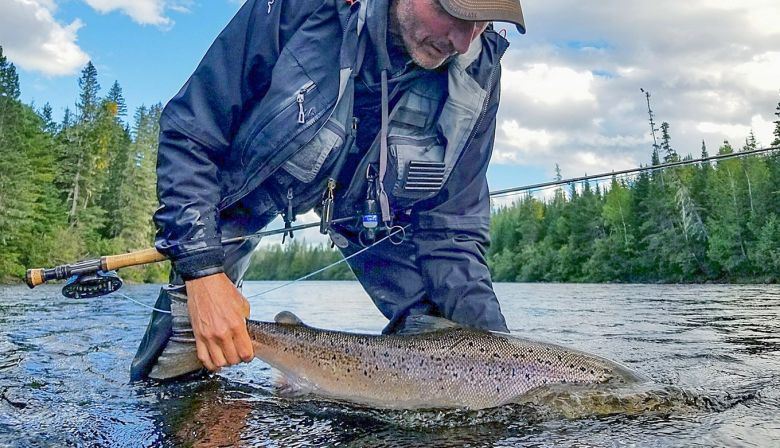
Subscribe & stay up-to-date with ASF

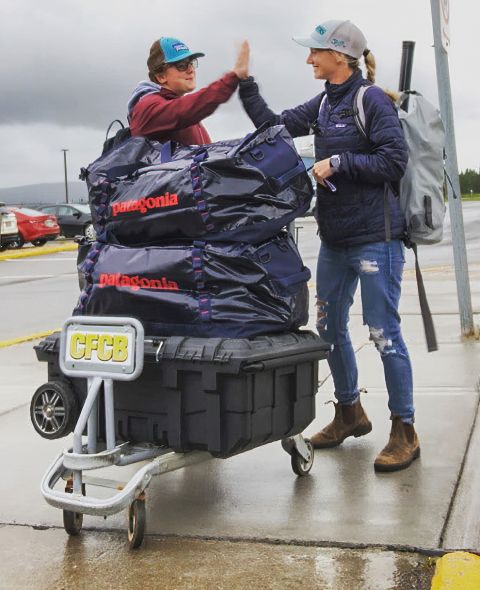
Kastine Coleman of Corner Brook last week was able to travel with her daughter Nevaeh to the Flowers River in Labrador, and has a few notes on the Atlantic salmon and the river. All the photos are courtesy of Kastine Coleman:
I travelled with my 14 year old daughter to Flowers River Labrador Aug 29-Sept 4 2020.
There was a lot of rain before our arrival, putting water levels up over the beach and into the alders. Silt filled the river and visibility was near zero making fishing tough. Here are the memorable fishing moments:
Day 1: Water temperature was about 8-9 degrees. I hooked two fish on a wet fly. The first was a fresh silver 6lb female (13 inch girth, 24.5 inches long). The second was about five pounds, and it had been in the river for some time. Memorable because we didn’t see another fish the entire day, nor did anyone else!
Day 2: Nevaeh hooked a fish about 6-7 pounds, fresh and healthy. I released a grilse around the same size.
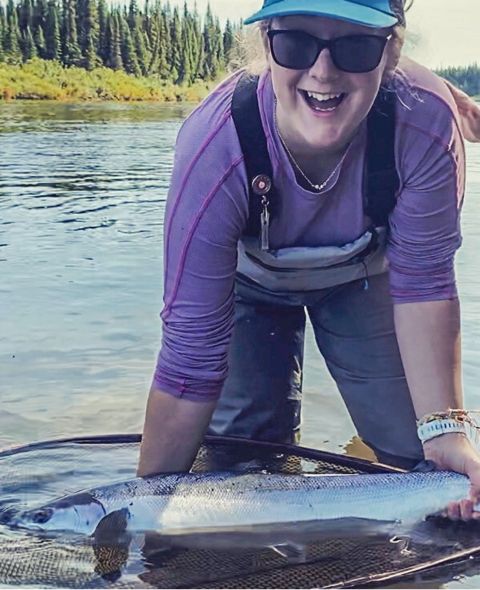
Day 4:
Water temperature had risen to about 10-11 degrees, and water level were still quite high but we were able to see some beach. We could sight fish again in the river.I hooked an 11 pound male on dry fly. (31.5 inch length, 15.5 inch girth) He was “coloured up”, sharp teeth and a nice-sized kype. He had a thick protective coating of slime.
Nevaeh hooked a 12 pound (32 inch length, 16 inch girth) silver fresh female on dry fly.
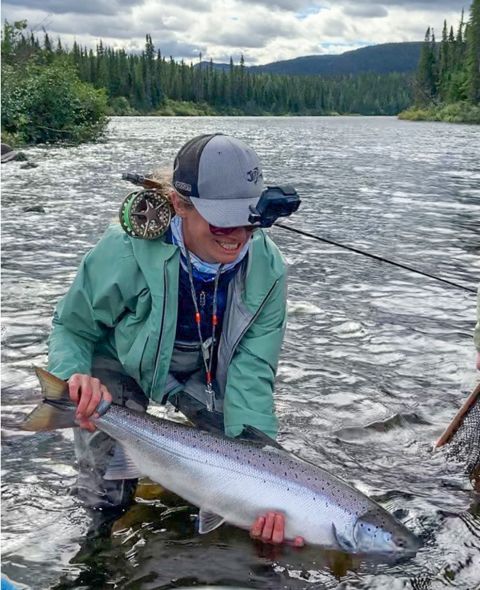
Day 5: Hooked 2 grilse that had been in the river for some time and 10-11 pound female. All on dry fly. The female was fresh & bright silver,
Day 6: Lost a beauty of a fish, pulled me to the end of my backing twice and down over the rapids before getting loose on a rock. The one that got away indeed! Hooked a 13 pound female shortly after on a dry fly, bright silver. 32 inch length, 16.5 inch girth.
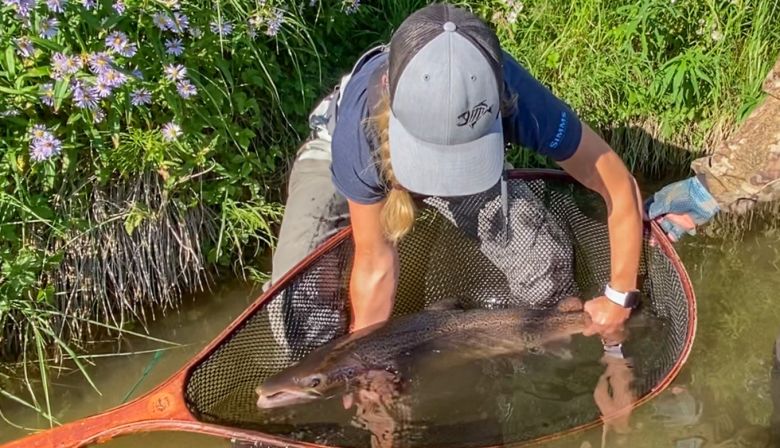
The new chef made up for tough conditions. She was top notch and every meal was incredible.
I absolutely love fishing at Flowers River Lodge in late August or early September because the fresh run of silver energetic fish are moving in in each day, and resemble June fish.
Air and water temps are cool, leading to great catch-and-release conditions. A huge bonus was watching my 14-year-old set a dry fly and play a 12 pound fish to the net on a 5 weight rod!
Final thoughts:
Connecting with salmon on this trip was a bonus…the real joy was sharing the experience with my daughter. We have memories that will last a lifetime.
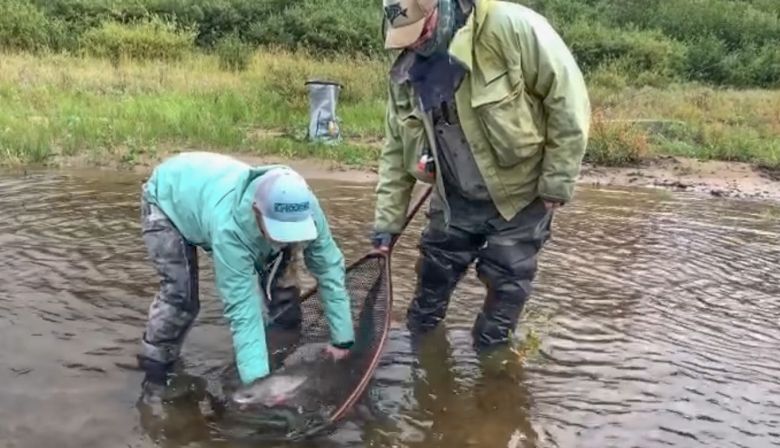
Improved angling conditions result in successful outings for anglers on many rivers in Newfoundland during the past week.
As expected, much needed rain and cooler air temperatures throughout Newfoundland during the last few days of August resulted in much improved water conditions on many rivers across the entire province during the first week of September.
As a result, most rivers on the Island that had been previously restricted to morning fishing only, due to poor environmental conditions, were reopened to all-day angling. The improved conditions resulted in good success during this past week for many of the die-hard anglers making time for one last late-season ‘flick’.
Note that the regular season on the Island of Newfoundland officially closed for most rivers on Sept 7. However, sections of the Humber River, Gander River, and Exploits River remain open until Oct 7 for a Fall fishery. Anglers are reminded to check the DFO website for information on which sections of these three rivers remain open for the Fall fishery.
Overall, based on all the reports I received from anglers on the Island during this past week there appears to have been a good sign of fish moving freely upriver on many rivers, including reports of a few bright fish on some rivers. This would suggest that some salmon had indeed been holding patiently in tidal waters for river conditions to improve before entering.
Hopefully these fish were counted before the fishways were officially closed for the season. It was also encouraging to hear from anglers that there was still a good sign of large fish on some rivers.
Anglers in Labrador reported improved conditions and good success on a number of rivers in that area, where a number of large fish were also reported to have been hooked and released. Note that the regular season in Labrador officially closes on all rivers on Sept 15.
Here is a sample of some of the reports we received this past week:
Randy Strangemore, a long-time guide with Tuckamore Outfitters, reported a good sign of fish on Main Brook last week, where a number of anglers were still fishing and enjoying success. He also reports that overall there was a great run of fish on Main Brook this year.
SPAWN Board Member, Collin Marsden, who also fished on the Northern Peninsula this past Saturday reports hooking five fish for the day on one of his favourite rivers.
Former SPAWN Director, Keith Cormier, reports seeing quite a few fish at Home Pool on Harry’s River during a days fishing there this past week. He also reports seeing some large fish in the pool.
Wayne Pierce and Kevin Power enjoyed a great day fishing on the Upper Humber this past week-end where they released four fish between them and also tagged a fish.
Well know angler Matt Byrne, hooked a large fish on the Lower Humber this past week at Leddingham’s Pool. It is also reported that Kent Green hooked a very large fish on the Lower Humber during this past week.
Outdoorsman Dave Vardy, reported a great day on Indian Arm River (a tributary of the Campbellton River) early last week where he saw a good sign of fish and also hooked and released several grilse. Dave also reports that there are a few fish being hooked on the Gander River but fishing has been slow because water levels are currently too high for good fishing.
Tolson Parsons reports that water conditions were good on the Terra Nova River this past week where a number of fish were also being hooked by anglers.
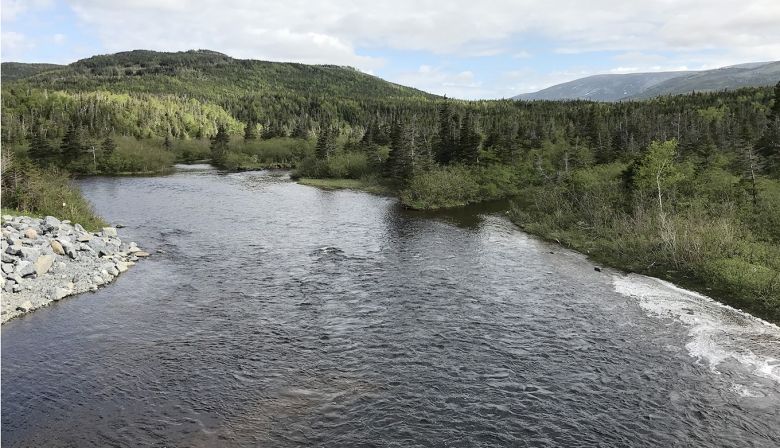
Things are pretty good here for such a strange year. The river was fishing very well, up until about a week ago when it went up about two feet. Still getting fish but they are a lot harder to find. Had a friend in yesterday who saw a few fish and landed a 19 in. sea trout.
With 23 days left in the very encouraging 2020 season, an excellent rain has fallen in strategic areas such as Murdochville and Amqui has helped many rivers recently. It should be quite a finish to the Atlantic salmon season with plenty of action.
The data used for the Quebec river notes are sourced from various river websites, social media and Quebec government sources. Information can change without prior notification regarding prior year comparative figures.
Il ne reste que 23 jours de pêche avant la fin de cette saison très encourageante. La pêche sportive promet d’être productive d’ici là, dame nature sera généreuse en matière de pluie a des endroits d’importance pour nos rivières tels que Murdochville en Gaspésie et Amqui dans le bas St-Laurent.
Les données utilisées dans ce rapport proviennent de divers sites web, des médias sociaux et de sources gouvernementales québécoises. Les informations peuvent changer sans avis au préalable en ce qui concerne les comparatifs des saisons précédentes.
During the summer of 2019, two pink salmon were captured in Nunavik specifically in the Ungava Bay region.
One of the salmon was caught in Kangirsuk, and the other in Kangiqsualujjuaq.
This year, an Inuk fisherman reported having caught two pink salmon in the Salluit area. These are the first official records of this exotic invasive species in Québec.
The MFFP would like to draw an up-to-date picture of the situation. This is where we need your help! Think you caught a pink salmon? We invite you to freeze the entire specimen and send it to the Nunavik Research Centre or contact MFFP by phone at 1 (877) 346-6763 or observations_eae@mffp.gouv.qc.ca
SAUMONS ROSES CAPTURÉS DANS LA BAIE D’UNGAVA −
Premières mentions de l’espèce au Nunavik
Deux saumons roses ont été capturés au Nunavik à l’été 2019, plus précisément dans la région de la baie d’Ungava. L’un des saumons a été capturé à Kangirsuk, et l’autre, à Kangiqsualujjuaq. Cette année, un pêcheur inuit aurait, lui aussi, capturé deux saumons roses dans le secteur de Salluit. Il s’agit des premières mentions officielles de cette espèce exotique envahissante au Québec. L’équipe du MFFP aimerait dresser un portrait actuel de la situation. Pour ce faire, votre collaboration est précieuse! Vous pensez avoir pêché un saumon rose? Nous nous invitons à prendre une photo du spécimen et à communiquer l’information au MFFP : par courriel au observations_eae@mffp.gouv.qc.ca – téléphone : 1 877 346-6763.

Most recent catch statistics are available at:
https://saumongaspe.com/en/peche-saumon-gaspe/statistiques.html
Les statistiques récentes des prises peuvent être consultées au :
https://saumongaspe.com/en/peche-saumon-gaspe/statistiques.html
To September 7th, for the season, 1,649 salmon and 1,001 grilse have counted for a total of 2,650. Anglers have reported landing 745 fish consisting of 245 salmon and 90 grilse released, 119 salmon and 291 grilse harvested.
On September 9th, 2019, 1,890 fish (1,198 salmon and 693 grilse) had been counted through the fishway. To the same date, 221 salmon and 41 grilse had been released along with 92 salmon and 245 grilse reported harvested for a grand total of 589.
Comparatively to September 18, 2018, 1,934 fish (1,051 salmon and 883 grilse) had been counted with a total of 451 reported catches (154 salmon and 49 grilse released along with 248 grilse harvested).
Cumulativement au 7 septembre, 1 649 saumons et 1 001 furent dénombrés pour un total de 2 650. Les pêcheurs sportifs ont signalé avoir pêché 745 poissons, dont 245 saumons et 90 madeleineaux relâchés, 119 saumons et 291 madeleineaux récoltés.
Le 9 septembre 2019, 1 890 poissons (1 198 saumons et 693 madeleineaux) avaient été dénombrés par le biais de la passe migratoire. À la même date, 221 saumons et 41 madeleineaux ont été relâchés, ainsi que 92 saumons et 245 madeleineaux récoltés pour un total de 589.
Comparativement au 18 septembre 2018, 1 934 poissons (1051 saumons et 883 madeleineaux) avaient été dénombrés en plus des 451 captures déclarées (154 saumons et 49 madeleineaux relâchés et 248 madeleineaux récoltés).
Rivière Bonaventure River
Bonaventure river anglers have reported, cumulatively for the season as of September 5th, 963 fish consisting of 657 salmon released and 306 grilse harvested.
For the season on September 7th, 2019, 921 fish had been reported landed (734 salmon released, and 187 grilse harvested).
Cumulatively on September 8th, 2018, 1,255 fish were reported laned by anglers ( 833 salmon released and 422 grilse harvested).
Les pêcheurs de la rivière Bonaventure ont rapporté, cumulativement pour la saison au 5 septembre, 963 poissons, soit 657 saumons relâchés et 306 grils capturés.
Au 7 septembre 2019, 921 prises furent enregistrées à ce jour (734 saumons relâchés et 187 madeleineaux récoltés).
Cumulativement, le 8 septembre 2018, la capture de 1 255 poissons avait été signalée par les pêcheurs sportifs (833 saumons relâchés et 422 grils capturés).

The Madeleine has also had a healthy increase in migration numbers. 1,692 fish (898 salmon and 794 grilse) have been counted for the season to September 5th.
To September 9th, 2019, a total of 529 large salmon and 212 grilse were counted migrating through the fishway for a total of 741 fish.
In comparison to September 8th, 2018, 355 large salmon and 328 grilse for a total of 683 fish were counted.
La Madeleine a également connu une forte augmentation de sa montaison comparativement à l’année dernière, 1 692 poissons (898 saumons et 794 madeleineaux) ont été dénombrés jusqu’au 5 septembre.
Au 9 septembre 2019, 529 saumons et 212 madeleineaux ont été dénombrés grâce à la passe migratoire pour un total de 741 poissons.
Par rapport au 8 septembre 2018 lorsque 355 grands saumons et 328 madeleineaux totalisant 683 poissons ont été dénombrés.
Rivière Matapedia River
To September 7th, anglers have landed a total of 1,146 fish, of which 674 have been reported released and 463 harvested. The breakdown of salmon harvested since August 1st is not available at this time.
Cumulatively to September 9th, 2019, 1,108 fish had been reported landed (669 large salmon released, and 439 grilse harvested).
In comparison for the same date in 2018, 1,006 (474 large salmon released and 532 fish (salmon and grilse) had been harvested.
Au 7 septembre, les pêcheurs de la Matapédia ont pêché jusqu’à ce jour 1 146 poissons, dont 674 relâchés et 463 récoltés. La ventilation des saumons récoltés depuis le 1er août n’est pas disponible pour le moment.
Cumulativement au 9 septembre 2019, 1 108 poissons avaient été déclarés débarqués (669 saumons relâchés et 439 madeleineaux récoltés).
Comparativement à la même date en 2018, 1 006 (474 saumons relâchés et 532 poissons (saumons et madeleineaux) avaient été récoltés.

The migration back to the Mitis continues to be impressive this season. To date on September 7th, 1,475 fish (738 salmon and 737 grilse) have been counted.
To September 8th, 2019, 878 fish (448 large salmon and 430 grilse) had been transported up above the natural waterfall. Also, to date, 102 large salmon have been released and 106 grilse had been reported harvested.
In 2018, cumulatively to September 19, 245 large salmon and 529 grilse had been counted and 43 salmon had been reported released and 122 grilse harvested.
La montaison de la Mitis continue d’être impressionnante cette saison. À ce jour, au 7 septembre, 1 475 poissons (738 saumons et 737 madeleineaux) ont été dénombrés.
Au 8 septembre 2019, 878 poissons (448 saumons et 430 madeleineaux) avaient été transportés en amont de la cascade naturelle. De plus, à ce jour, 102 saumons ont été relâchés et 106 madeleineaux ont été déclarés récoltés.
En 2018, cumulativement au 19 septembre, 245 saumons et 529 madeleineaux avaient été dénombrés et 43 saumons avaient été relâchés par les pêcheurs sportifs et 122 grils avaient été récoltés.
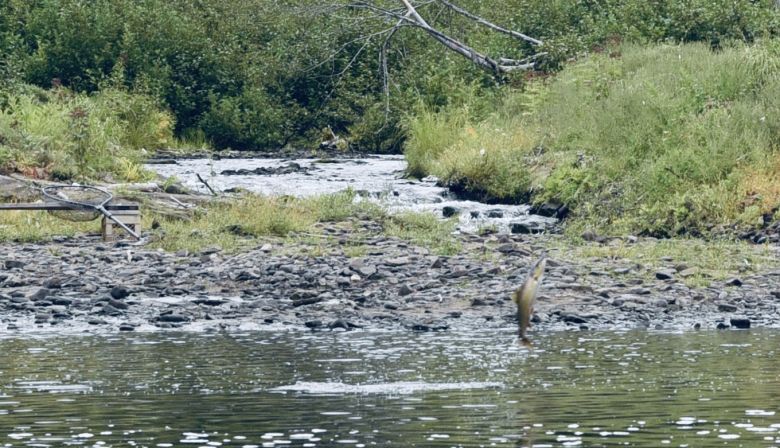
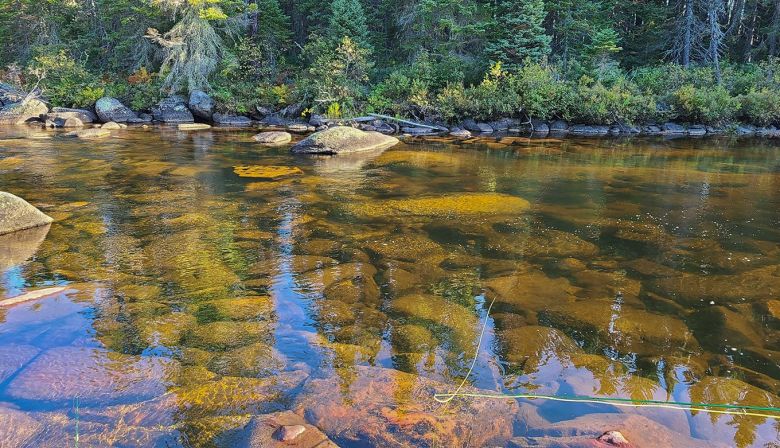
The Dungarvon Barrier on this tributary of the Southwest Miramichi counted a single grilse during the week to Sept. 6. There have been 87 grilse and 70 large salmon, vs. 81 grilse and 68 large salmon iun 2019.
Paul Elson has been out, and has some recent observations:
I had the privilege of fishing the North Pole Stream Sinclair stretch Crown Reserve on the weekend. Water was very low and has almost completely lost it’s colour. As background, I’ve never saw the ‘Pole” go clear in 20+ years of fishing it. The LSW and NW are both clear as well from the low water.
Fishing was slow at best and the fish were easily spooked. We did manage to hook 6-7 fish between the group. I’m still waiting for a hurricane…it’s going to be a tough fall if we don’t get some serious water.
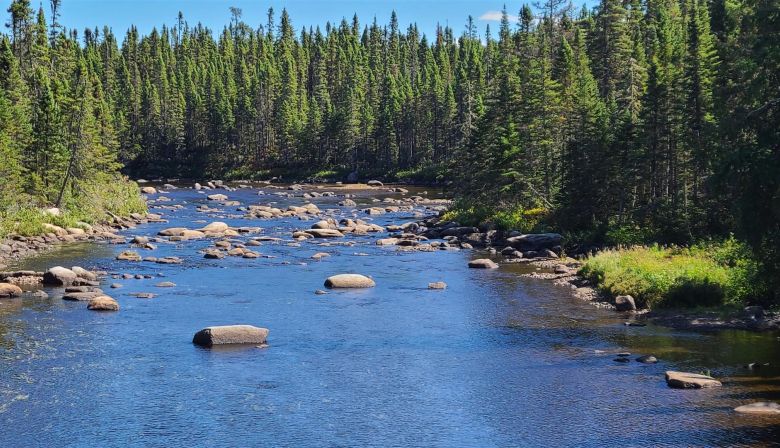
At least the water has cooled off. And where there are pools, there are Atlantic salmon in them. With the cooler water we have been hearing reports of some excellent fishing in the major holding pools where salmon are waiting for fall rains so that they can spread out.
In other areas where there are no holding pools, the fishing is tough and everyone is waiting for a raise in water to bring in new fall run salmon and spread the fish out in the river.
September is an important time of year for completing conservation projects like cold water enhancements.
This week and next, contractors are breaking ground at two cold water enhancement sites at Wildcat Brook on the Northwest Miramichi and at McKenzie Brook on the Southwest Miramichi.
These are part of a larger four year cold water improvement program led by Anqotum and ASF with partners MSA and the University of New Brunswick.
We will also do a third site this month, Sutherland Brook on the Northwest Miramichi.
September is the ideal month to carry out this work in the river with heavy machinery because the warm water period has passed, and now salmon are not limited to those cold water areas where the work will take place. The water is also low, which is a key ingredient for doing in-river work with machinery.
Restigouche
On the Restigouche, the month of September is a time when David Leblanc and the Restigouche River Watershed Management Council prepares for giving the salmon a helping hand during spawning.
The organization surveys the watershed for beaver dams that block access to productive spawning areas, and then in October the troops enter on the ground and notch the dams, allowing salmon to pass. We are not talking a handful of dams, there are hundreds. Beavers quickly rebuild the dams but by that time salmon have gone through to spawn in those productive nursery areas.
Monitoring by electrofishing is showing this program is working to boost juvenile productivity above those beaver dams.
The RRWMC is also doing work this month with the potato farmers in St. Quentin to reduce runoff from potato fields into Five Fingers Brook, which runs into the Little Main Restigouche. Those who have spent time on the Restigouche after a thunderstorm and have witnessed the level of siltation understand the importance of this work.
The RRWMC is doing a great job working toward improvements.
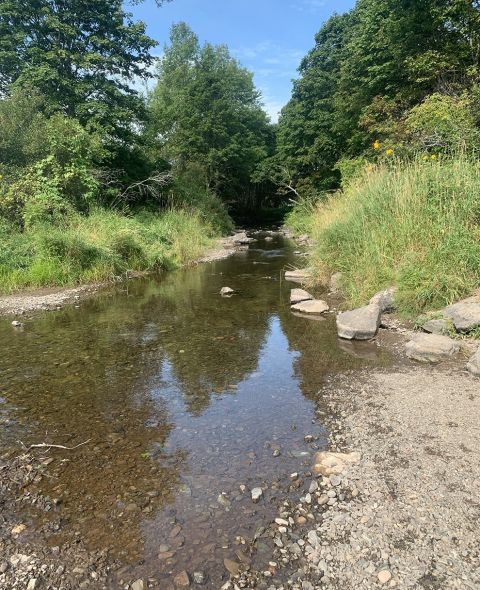
So far there hasn’t been much happening in the fall salmon season in Nova Scotia.
Anglers are gearing up and are reporting seeing salmon in the estuaries but as of yet no one is reporting fresh fish entering the fall run Northumberland Strait Rivers.
Dave MacNeil of the Antigonish Rivers Association says that their members and supporters are seeing fish jumping in the harbour from Dunn’s Beach to Jimtown. This has been the norm for early September in recent years, so the ARA is confident so we should see some fish nosing in once the water cools.
I walked the lower portions of West River (Antigonish) and did not see a fish, which wasn’t surprising given the lack of rain and low water levels. Other anglers are also concerned about the low water levels.
Matt Dort of Pictou County River Association reports that they are not seeing any fish around the tidal pools of the East (Pictou), West (Pictou), and Barney’s rivers. He says that the water is still extremely low and he figures that rivers need a lot of rain for the ground to become saturated and raise water levels to bring in the Atlantic salmon.
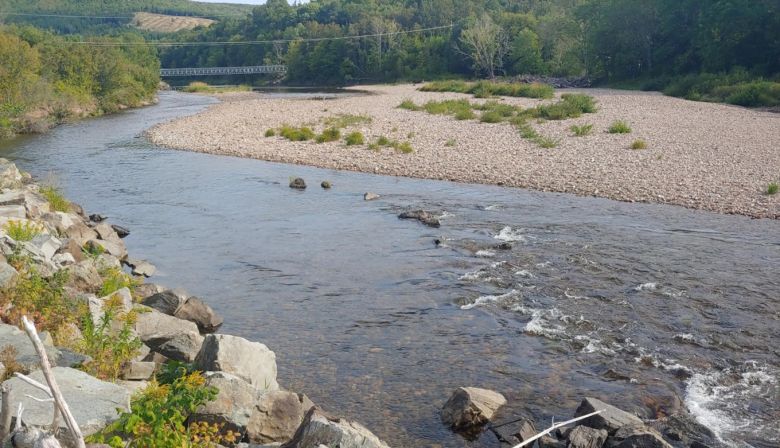
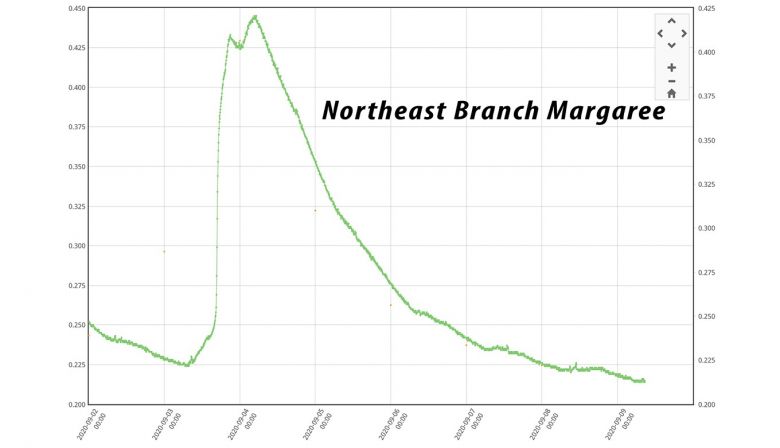
Nothing really to report from PEI. Water remains low (no surprise there).
The usual number of perhaps a dozen summer fish are holding at a couple pools on the Morell but I wouldn’t expect to see any real numbers until the first week of October, let alone any catches.
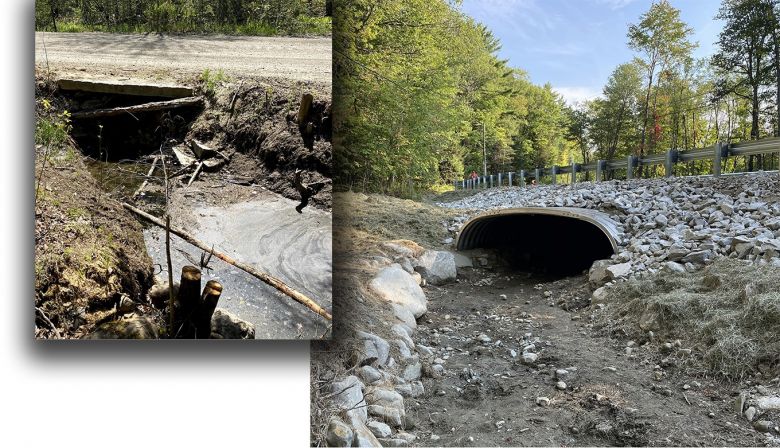
The Clover Mill Road crossing of a tributary of Temple Stream now gives migratory fish the chance to proceed upstream to spawning areas. However the drought conditions mean that significant rainfall is now needed.